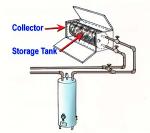Search engine visitors - click here to access entire "$ensible Home" web site
Click here to see a descriptive illustration of several do-it-yourself batch solar water heater designs.
Dear Jim: I want to become more green and my children are all for it. From what I have read, using a solar water heater makes the most sense. I don't have much money for one. How can we build a simple one ourselves? - Pat F.

A: Using solar energy in your home is about as "green" as living can get. Working on a project to build a simple solar heater is a great family project and can be an excellent learning tool for your children. It is also good for the environment, which your children will have to live in for the next 80 years or so. Reducing overall electricity demand for water heating, especially during hot summer afternoons, can help reduce the need for additional power plants and moderate rate increases over time.
Other than solar swimming pool or spas system, solar domestic water heating makes the most economic sense of all solar systems. This is because hot water is needed year-round and water has a very high thermal mass capacity for storing the captured solar heat. Heated water can be moved efficiently through insulated pipes without pumps. The normal house water pressure moves it through the solar system and into your house.
In contrast, whole-house solar space heating systems, unless you make a simple do-it-yourself window heater for one room, often are not cost effective for most of the country. Space heating is typically needed for only about six months each year. Its maximum solar heat output is needed during the winter when the daylight hours are shortest and the sun is most indirect. In some regions, such as Cincinnati where I live, there often is a cloud cover on winter days.
Since your budget is limited and your children want to help, building a simple batch-type solar water heater is your best option for this project. This is not as effective as an elaborate active solar system with an array of solar collectors on the roof, but it does not cost thousands of dollars either. Depending upon the types of scrap materials you can find around the house, you should be able to build a batch system for less than $200 and the savings will payback its cost in a couple of years.
The hot water heating energy savings you can expect to realize depend upon the specific design and your climate. The sun is more direct in southern climates and less heat is lost to its warmer outdoor air. During the summer, a 50-percent savings on your water heating costs is reasonable as is a 25-percent savings during fall and spring. In many areas of the country, it is best to bypass the solar heater during winter to avoid freezing and possible damage to the solar heater or plumbing.
A batch solar water heater is used a preheater for the incoming cold water before it reaches your standard water heater. If the incoming water is warmer, it takes less gas or electricity to heat it to the regular hot water temperature (120 degrees is best). On a hot sunny summer afternoon, the solar heater can warm water enough so that the water heater stays off all day.
The most common design of batch solar water heater uses a water tank inside of an insulated box with a clear top. Special solar water heating tanks can be purchased, but first contact local plumbers to find one or two old discarded water heater which do not leak. Strip off the sheet metal skin and insulation to expose the steel tank. It is easy to attach the plumbing because the old tank already has all the plumbing fittings and a pressure relief safety valve.
The water heater tank should be painted flat black. Special solar paints, which are formulated to absorb more solar heat, are also available at a reasonable cost. If you can find one, use an old glass storm door or window for the clear top or buy a sheet of clear acrylic plastic. For the greatest year-round solar gain, slope the clear top at an angle equal to your latitude angle.
Run the hot water outlet pipe from the tank through the back or side of the box and then down near the ground into your house to the water heater. Run another incoming cold water pipe from the water heater to the solar heater. Insulate them very well. Install a crossover pipe and two valves to bypass the solar water heater during winter in cold climates.
Instant Download Update Bulletin No. 695 - do-it-yourself instructions, diagrams and required materials list for making several designs of batch solar water heaters (one-tank batch heater, basic two-tank batch heater) and a plumbing schematic, diagrams of alternative designs of batch solar water heaters and a list of ready-to-use batch solar kits.
Dear Jim: I like the look of a cedar fence around my front yard, but the posts seem to rot and break every five years or so. Can I use galvanized posts like the type used for chain link fence with the cedar? - Judy M.
A: I suppose that could be done somehow, but it may not look as nice as you would like. A better option would be to use standard cedar posts, but mount them in metal post anchors instead of directly in the ground.
Another option is to use vinyl fence posts. Vinyl fencing products are a little more expensive initially, but with no maintenance and considering their long life, they may be the most attractive and cost-effective option.